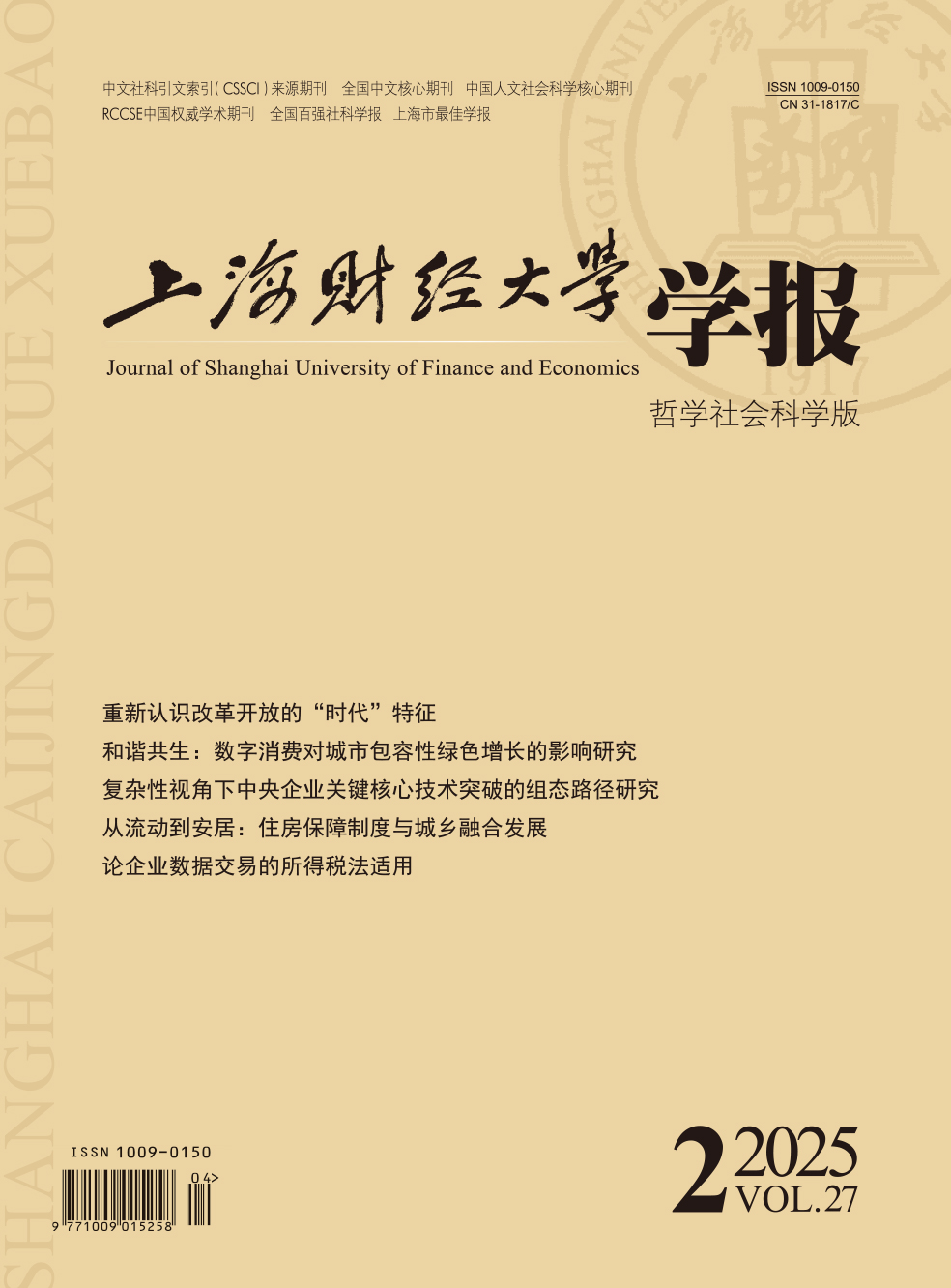中国家庭家务时间配置的福利效应——基于性别差异和城乡背景的比较分析
上海财经大学学报 2015 年 第 17 卷第 06 期, 页码:35 - 46
摘要
参考文献
摘要
劳动力的时间配置结构关系到个人及其家庭的福利,家务时间的配置又受到工作性质与特征的影响,且这种影响因性别差异和城乡背景在效应结构上存在差别.文章利用CHNS的调查数据进行了比较,结果发现:从事的工作中平均学历越高,会减轻女性的家务负担,但增加了男性的家务时间配置,家庭内部的性别分工更趋平等;从事的工作中平均收入越高,男性会减少家务时间,但女性却会增加家务时间;工作时间的灵活性对于城镇劳动力从事家务劳动的"时间约束"要强于农村劳动力;收入提高会促使农村劳动力减少家务时间,但对城镇劳动力的影响不明显.文章强调了工作特征在性别和经济社会背景两个维度下影响家务时间配置的不同机制,对于探索促进性别平等和城乡福利均等化的路径有重要的参考意义.
关键词
[1] 贝克尔. 家庭论[M]. 王献生、王宇译,北京:商务印书馆,2005.
[2] 畅红琴,董晓媛,Fiona MacPhail. 经济发展对中国农村家庭时间分配性别模式的影响[J].中国农村经济,2009,(12).
[3] 陆益龙. 户口还起作用吗——户籍制度与社会分层和流动[J]. 中国社会科学,2008,(1).
[4] 齐良书. 议价能力变化对家务劳动时间配置的影响——来自中国双收入家庭的经验证据[J].经济研究,2005,(9).
[5] 王美艳. 城市劳动力市场上的就业机会与工资差异——外来劳动力就业与报酬研究[J]. 中国社会科学,2005,(5).
[6] 王亚林. 城镇居民家务劳动动态考察[J]. 社会学研究,1991,(3).
[7] 王济川,谢海义,姜宝法. 多层统计分析模型——方法与应用[M]. 北京:高等教育出版社,2008.
[8] 伍德里奇. 计量经济学导论:现代观点[M]. 费剑平译,北京:中国人民大学出版社,2003.
[9] 严善平. 人力资本、制度与工资差别——对大城市二元劳动力市场的实证分析[J]. 管理世界,2007,(6).
[10] Alenezi M., Walden M. L. A New Look at Husbands' and Wives' Time Allocation[J]. The Journal of Consumer Affairs, 2004,38(1):81-106.
[11] Allen M. Parkman. Bargaining over Housework: The Frustrating Situation of Secondary Wage Earners[J]. American Journal of Economics and Sociology, 2004, 63(4):765-794.
[12] Begoña, Daniel M. Gender Effect on Housework Allocation: Evidence from Spanish Two-Earner Couples[J]. Journal of Population Economics, 2003, 16(2):227-242.
[13] Bielby Denise D.,William T. Bielby. She Works Hard for the Money: Household Responsibilities and the Allocation of Work Effort[J]. American Journal of Sociology, 1988, 93(5):1031-1059.
[14] Cheng Tiejun,Mark Selden. The Origins and Social Consequences of China's Hukou System[J].The China Quarterly,1994,(139):644-668.
[15] Dorothy J. Solinger. Citizenship Issues in China's Internal Migration: Comparisons with Germany and Japan[J]. Political Science Quarterly, 1999,114(3):455-478.
[16] Hiller D. Power Dependence and Division of Family Work[J]. Sex Roles,1984,10(11-12):1003-1019.
[17] Ishii-Kuntz, Masako,Scott Coltrane. Predicting the Sharing of Household Labor: Are Parenting and Housework Distinct?[J]. Sociological Perspectives, 1992,35(4):629-647.
[18] Joni H.,Leslie S. Stratton.Housework Wages,and Division of Housework Time for Employed Spouses[J]. The American Economic Review,1994,84(2): 120-125.
[19] Krista L. McGuire, Richard B. Primack, Elizabeth C. Losos. Dramatic Improvements and Persistent Challenges for Women Ecologists[J]. BioScience, 2012, 62(2):189-196.
[20] Malathy R. Education and Women's Time Allocation to Nonmarket Work in an Urban Setting in India[J].Economic Development and Cultural Change,1994, 42(4): 743-760.
[21] McElroy M.B.,Horney M. J. Nash-Bargaining Household Decisions: Toward a Generalization of the Theory of Demand[J]. International Economic Review, 1981, 22(2):333-349.
[22] Pirore M. J. The Dual Labor Market: Theory and Application[R]. Cambridge Mass Winthop,1970.
[23] Ravi K., Lawrence H. Are Better Off Households More Unequal or Less Unequal?A Bargaining Theoretic Approach to "Kuznets Effects" at the Micro Level[R]. Oxford Economic Papers ,1994.
[24] Thomas A., Sven-Olov D., Magnus Wikström. Estimating Intra-household Allocation in a Collective Model with Household Production[J]. Journal of Population Economics,2001, 14(4): 569-584.
[2] 畅红琴,董晓媛,Fiona MacPhail. 经济发展对中国农村家庭时间分配性别模式的影响[J].中国农村经济,2009,(12).
[3] 陆益龙. 户口还起作用吗——户籍制度与社会分层和流动[J]. 中国社会科学,2008,(1).
[4] 齐良书. 议价能力变化对家务劳动时间配置的影响——来自中国双收入家庭的经验证据[J].经济研究,2005,(9).
[5] 王美艳. 城市劳动力市场上的就业机会与工资差异——外来劳动力就业与报酬研究[J]. 中国社会科学,2005,(5).
[6] 王亚林. 城镇居民家务劳动动态考察[J]. 社会学研究,1991,(3).
[7] 王济川,谢海义,姜宝法. 多层统计分析模型——方法与应用[M]. 北京:高等教育出版社,2008.
[8] 伍德里奇. 计量经济学导论:现代观点[M]. 费剑平译,北京:中国人民大学出版社,2003.
[9] 严善平. 人力资本、制度与工资差别——对大城市二元劳动力市场的实证分析[J]. 管理世界,2007,(6).
[10] Alenezi M., Walden M. L. A New Look at Husbands' and Wives' Time Allocation[J]. The Journal of Consumer Affairs, 2004,38(1):81-106.
[11] Allen M. Parkman. Bargaining over Housework: The Frustrating Situation of Secondary Wage Earners[J]. American Journal of Economics and Sociology, 2004, 63(4):765-794.
[12] Begoña, Daniel M. Gender Effect on Housework Allocation: Evidence from Spanish Two-Earner Couples[J]. Journal of Population Economics, 2003, 16(2):227-242.
[13] Bielby Denise D.,William T. Bielby. She Works Hard for the Money: Household Responsibilities and the Allocation of Work Effort[J]. American Journal of Sociology, 1988, 93(5):1031-1059.
[14] Cheng Tiejun,Mark Selden. The Origins and Social Consequences of China's Hukou System[J].The China Quarterly,1994,(139):644-668.
[15] Dorothy J. Solinger. Citizenship Issues in China's Internal Migration: Comparisons with Germany and Japan[J]. Political Science Quarterly, 1999,114(3):455-478.
[16] Hiller D. Power Dependence and Division of Family Work[J]. Sex Roles,1984,10(11-12):1003-1019.
[17] Ishii-Kuntz, Masako,Scott Coltrane. Predicting the Sharing of Household Labor: Are Parenting and Housework Distinct?[J]. Sociological Perspectives, 1992,35(4):629-647.
[18] Joni H.,Leslie S. Stratton.Housework Wages,and Division of Housework Time for Employed Spouses[J]. The American Economic Review,1994,84(2): 120-125.
[19] Krista L. McGuire, Richard B. Primack, Elizabeth C. Losos. Dramatic Improvements and Persistent Challenges for Women Ecologists[J]. BioScience, 2012, 62(2):189-196.
[20] Malathy R. Education and Women's Time Allocation to Nonmarket Work in an Urban Setting in India[J].Economic Development and Cultural Change,1994, 42(4): 743-760.
[21] McElroy M.B.,Horney M. J. Nash-Bargaining Household Decisions: Toward a Generalization of the Theory of Demand[J]. International Economic Review, 1981, 22(2):333-349.
[22] Pirore M. J. The Dual Labor Market: Theory and Application[R]. Cambridge Mass Winthop,1970.
[23] Ravi K., Lawrence H. Are Better Off Households More Unequal or Less Unequal?A Bargaining Theoretic Approach to "Kuznets Effects" at the Micro Level[R]. Oxford Economic Papers ,1994.
[24] Thomas A., Sven-Olov D., Magnus Wikström. Estimating Intra-household Allocation in a Collective Model with Household Production[J]. Journal of Population Economics,2001, 14(4): 569-584.
引用本文
胡军辉. 中国家庭家务时间配置的福利效应——基于性别差异和城乡背景的比较分析[J]. 上海财经大学学报, 2015, 17(6): 35–46.
导出参考文献,格式为:





 6627
6627  0
0

